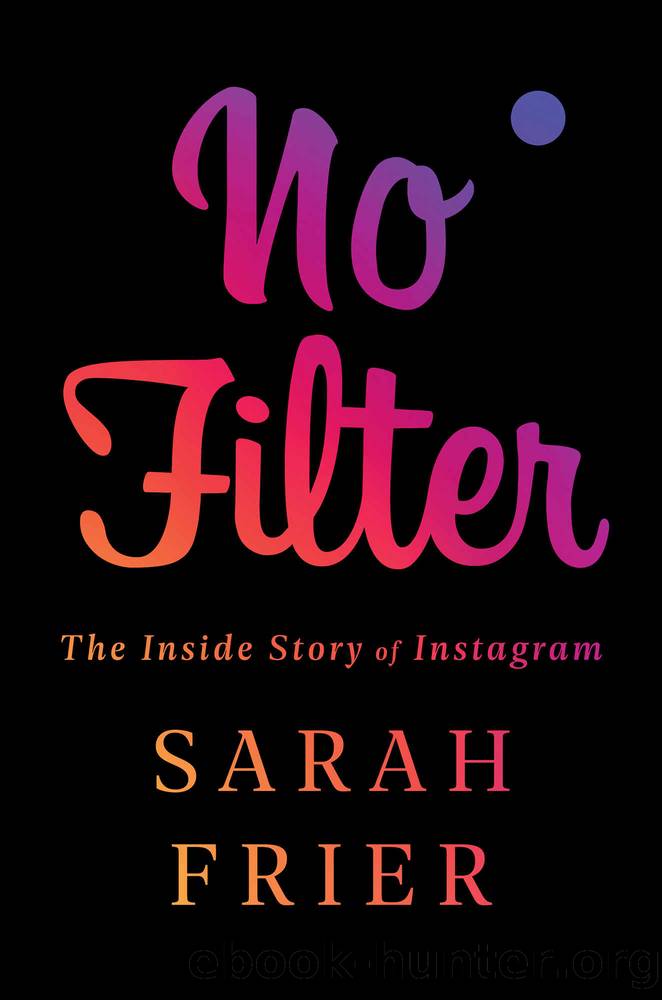No Filter: The Inside Story of Instagram by Sarah Frier

Author:Sarah Frier [Frier, Sarah]
Language: eng
Format: azw3
Publisher: Simon & Schuster
Published: 2020-04-13T16:00:00+00:00
* * *
Instagram was trying to curate what people talked about and saw on the app so the company would have more control over its destiny. Facebook had proved that the bigger a network became, the bigger the unintended consequences of its decisions. Instagram wanted to borrow what was working without making the same mistakes. Facebook, now with more than 1.4 billion users, had shaped the goals of people and businesses in such a way that everyone was tailoring their content to achieve the top reward on the social network: going viral.
Facebook employees, who were taught that sharing was central to the mission of “connecting the world,” applied certain strategies to make it a habit. The algorithm was hyper-personalized, so that any time someone clicked or shared something on Facebook, Facebook would log it as a positive experience and deliver more of the same. But virality had pitfalls. It addicted Facebook’s users to low-quality content. The Instagram employees wondered, was a click even an accurate signal of what a user wanted? Or were they being manipulated by the content itself? The viral links had headlines like, “This Man Got in a Fight at a Bar and You’ll Never Guess What Happened Next” and “We Saw Pictures of This Child Actress All Grown Up, and WOW!”
Facebook employees had seen their stock options soar in value from rapid growth that came, in part, from not judging their users’ choices. They would complain that the Instagram team had the luxury of making different decisions, taking Facebook’s resources for granted with an attitude of superiority. Part of that was because Instagram felt it had dodged the virality bullet.
All the editorial work only served to reinforce with Instagram employees that they had succeeded in building a pristine creative paradise on the internet, full of things people didn’t know they wanted to see until Instagram showed those things to them. Just like Facebook employees had been indoctrinated into the “connecting the world” mission, Instagram employees were buying their own branding.
But cracks in Instagram’s careful, relationship-based plan were starting to show. As more users joined Instagram, the small team became more disconnected from the experience of the average person. For every Cyrus and Jenner, there were millions of others who would never know what it was like to have their concerns heard by an Instagram employee. The ratio was now something like one employee for every 1.5 million users. And Cyrus and Jenner were highlighting real problems, like anonymous bullying and teens striving for perfection, that were systemic, propagated by Instagram’s own product decisions, like the ability to post anonymously or compete on follower counts.
Systrom wanted Facebook-size success. He also wanted to avoid cheapening anything about the product, ruining what it stood for. But Instagram was growing so quickly, he couldn’t have it both ways. Mark Zuckerberg made that very clear to him—first with the advertising business.
Download
This site does not store any files on its server. We only index and link to content provided by other sites. Please contact the content providers to delete copyright contents if any and email us, we'll remove relevant links or contents immediately.
| Biographies | Company Profiles |
| Economic History |
Pale Blue Dot by Carl Sagan(3995)
The Rules Do Not Apply by Ariel Levy(3897)
Goodbye Paradise(2949)
Delivering Happiness by Tony Hsieh(2917)
Liar's Poker by Michael Lewis(2805)
Into Thin Air by Jon Krakauer(2695)
Purple Cow by Seth Godin(2694)
Ogilvy on Advertising by David Ogilvy(2677)
Rogue Trader by Leeson Nick(2469)
The Airbnb Story by Leigh Gallagher(2363)
The Social Psychology of Inequality by Unknown(2304)
The Mind Map Book by Tony Buzan(2074)
Six Billion Shoppers by Porter Erisman(1995)
Bossypants by Tina Fey(1982)
Claridge's: The Cookbook by Nail Martyn & Erickson Meredith(1958)
All the President's Men by Carl Bernstein & Bob Woodward(1955)
Master of the Game by Sidney Sheldon(1876)
Alibaba by Duncan Clark(1751)
Wild Ride by Adam Lashinsky(1655)
